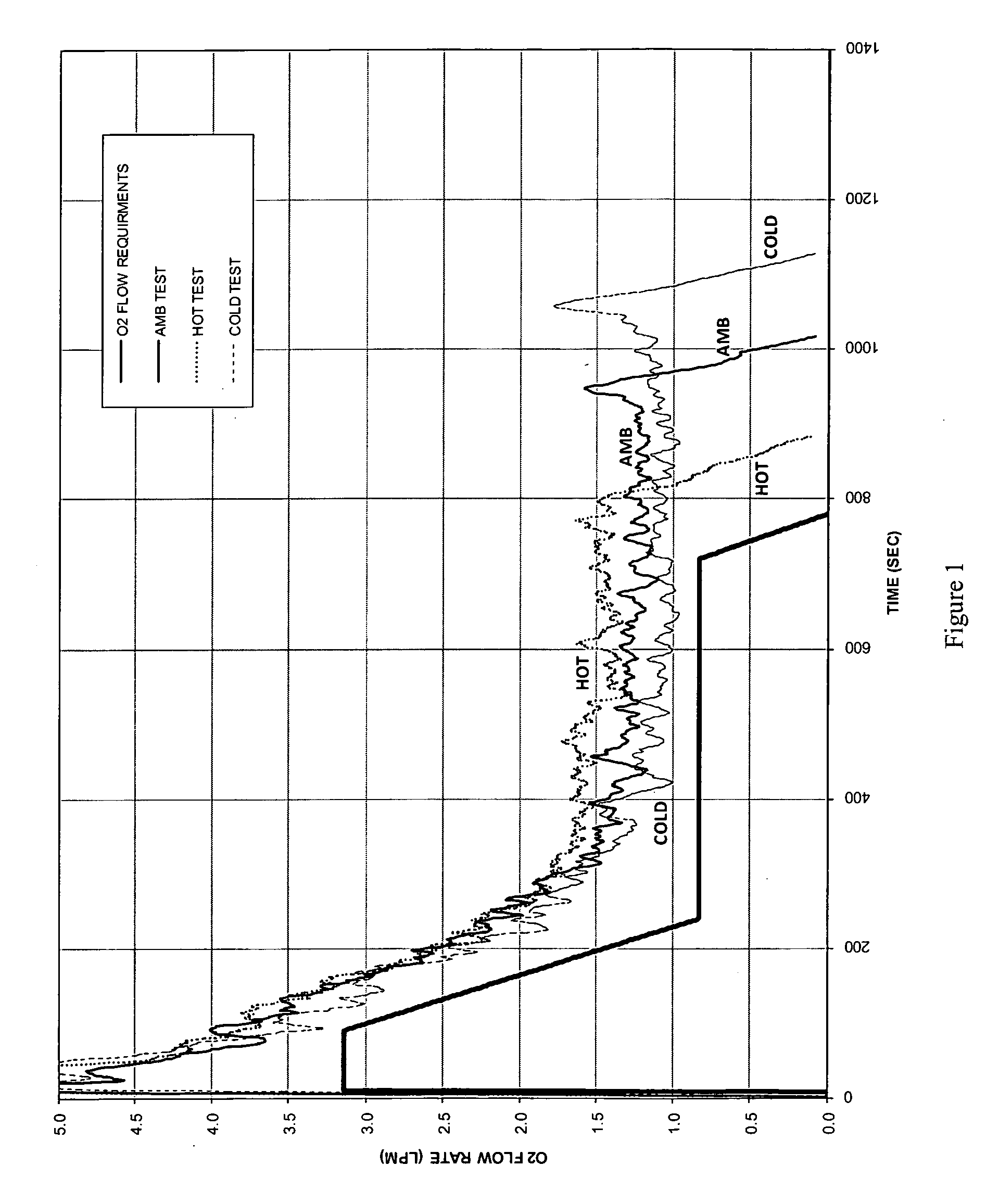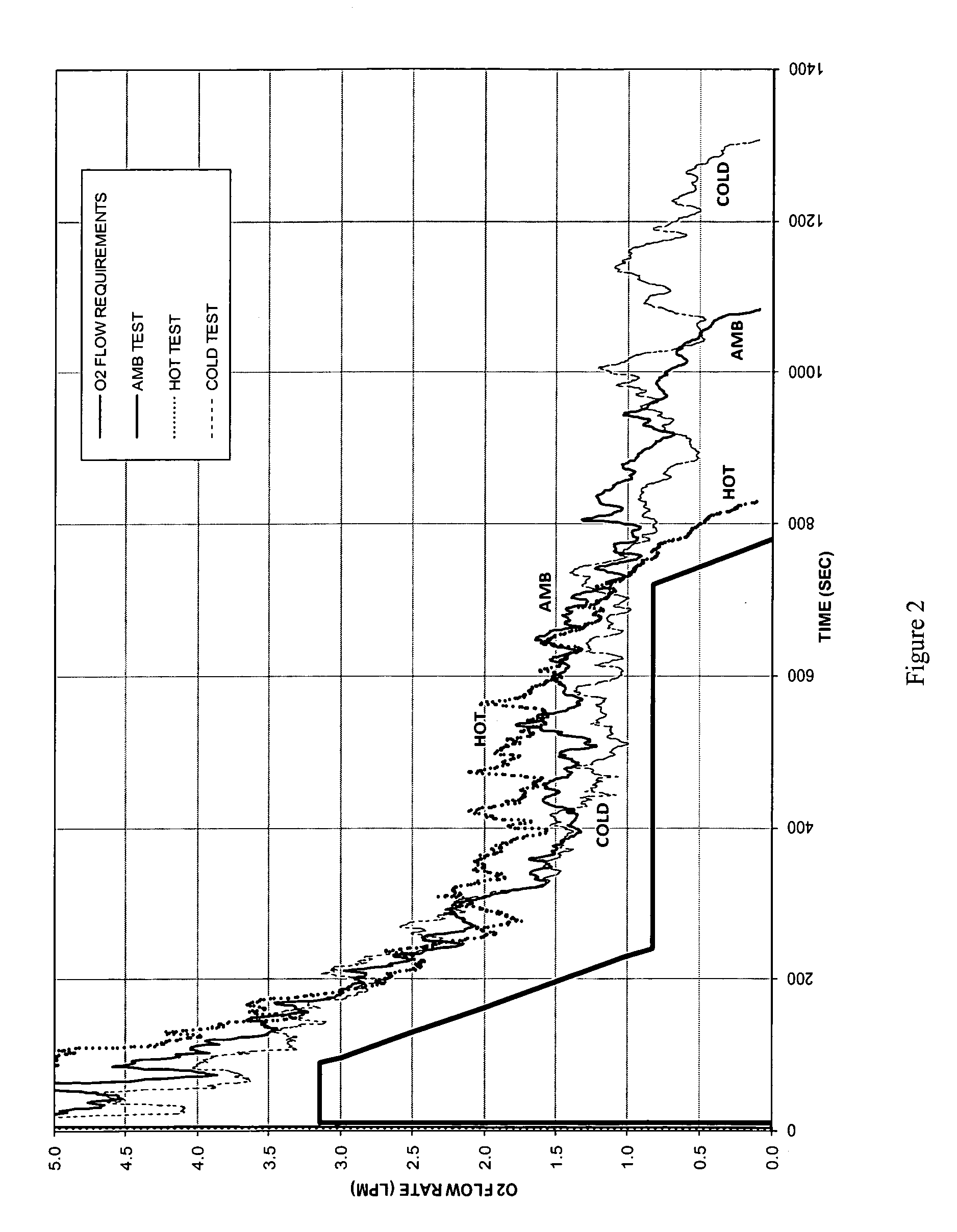Oxygen generating composition
a technology of oxygen generating composition and composition, which is applied in the direction of fire extinguishers, other chemical processes, explosives, etc., can solve the problems of inability to rely on catalysts, inability to achieve the effect of generating oxygen, and inability to achieve oxygen generation without catalysts, etc., to achieve the effect of reducing the sensitivity to temperature effects on oxygen generation, reducing the formation of chlorine gas, and improving reaction rate control
- Summary
- Abstract
- Description
- Claims
- Application Information
AI Technical Summary
Benefits of technology
Problems solved by technology
Method used
Image
Examples
example 1
[0042]Examples 1-3 demonstrate the effect of feldspar in an oxygen generating composition of the invention. The following parameters apply to Example 1.[0043]Mix I: 1.97% Feldspar, 89.05% NaClO3, 2.47% Fe, 1.28% MnO2, 1.27% KOH, 2.96% mica, 0.50% anhydrous aluminum silicate, 0.50% fumed silica.[0044]Mix II: 1.48% Feldspar, 89.35% NaClO3, 2.47% Fe, 1.97% MnO2, 1.27% KOH, 3.46% mica.[0045]Mix III: 0.99% Feldspar, 89.45% NaClO3, 2.86% Fe, 1.48% MnO2, 1.27% KOH, 2.96% mica, 0.50% silica flour, 0.50% fumed silica.
Mixes I, II, and III are formulations all containing different percentages of feldspar.
TABLE 3FORMULATION / COMPONENTS% OTHEROUTPUT% COMPONENT% AnhydrousMICA,AVEAVE(SiO2 / Al2O3)AluminumCabosilFLOW[Cl2]MIX% FELDSPARof FELDSPAR% NaClO3% Fe% MnO2% KOHSilicateSiO2LPMPPMI1.970.0089.052.471.281.270.503.46~1.2~170II1.480.0089.352.471.971.270.003.46~1.6~200III0.990.0089.452.861.481.270.003.96~1.7~290
[0046]As can be seen from Table 3, using feldspar as an additive in an oxygen candle sustai...
example 2
[0047]The following parameters apply to Example 2:[0048]Mix I: 1.97% Feldspar, 89.05% NaClO3, 2.47% Fe, 1.28% MnO2, 1.27% KOH, 2.96% mica, 0.50% anhydrous aluminum silicate, 0.50% fumed silica.[0049]Mix A: 0.00% Feldspar, 91.02% NaClO3, 2.47% Fe, 1.28% MnO2, 1.27% KOH, 2.96% mica, 0.50% anhydrous aluminum silicate, 0.50% fumed silica.[0050]Mix B: 0.00% Feldspar, 89.31% NaClO3, 2.47% Fe, 1.28% MnO2, 1.27% KOH, 2.96% mica, 0.50% anhydrous aluminum silicate, 0.50% fumed silica, 1.34% SiO2, 0.38% Al2O3.[0051]Mix C: 0.00% Feldspar, 89.05% NaClO3, 2.47% Fe, 1.28% MnO2, 1.27% KOH, 4.44% mica, 0.74% anhydrous aluminum silicate, 0.74% fumed silica.
[0052]Mixes A, B, and C are permutations of Mix I where Mix A maintains a constant % Other and increases the % of NaClO3 in place of the feldspar, Mix B contains the components of feldspar in place of the feldspar, and Mix C maintains a constant % NaClO3 and increases the % Other in place of the feldspar. The data is summarized in Table 4.
TABLE 4FO...
example 3
[0054]The following parameters apply to Example 3:[0055]Mix II: 1.48% Feldspar, 89.35% NaClO3, 2.47% Fe, 1.97% MnO2, 1.27% KOH, 3.46% mica.[0056]Mix D: 0.00% Feldspar, 89.35% NaClO3, 2.47% Fe, 1.97% MnO2, 1.27% KOH, 3.46% mica, 1.48% anhydrous aluminum silicate.[0057]Mix E: 0.00% Feldspar, 89.35% NaClO3, 2.47% Fe, 1.97% MnO2, 1.27% KOH, 3.46% mica, 1.48% Olivine.[0058]Mix III: 0.99% Feldspar, 89.45% NaClO3, 2.86% Fe, 1.48% MnO2, 1.27% KOH, 2.96% mica, 0.50% silica flour, 0.50% fumed silica.[0059]Mix F: 0.00% Feldspar, 89.45% NaClO3, 2.86% Fe, 1.48% MnO2, 1.27% KOH, 2.96% mica, 0.99% TiO2, 0.50% fumed silica, 0.50% SiO2.[0060]Mix G: 0.00% Feldspar, 89.45% NaClO3, 2.86% Fe, 1.48% MnO2, 1.27% KOH, 2.96% mica, 0.99% anhydrous aluminum silicate, 0.50% fumed silica, 0.50% SiO2.
[0061]Mixes D and E are permutations of Mix II where Mix D replaces the % feldspar with anhydrous aluminum silicate and Mix E replaces the % feldspar with olivine. Likewise, Mixes F and G are permutations of Mix III...
PUM
| Property | Measurement | Unit |
|---|---|---|
| flow rate | aaaaa | aaaaa |
| temperatures | aaaaa | aaaaa |
| temperatures | aaaaa | aaaaa |
Abstract
Description
Claims
Application Information
 Login to View More
Login to View More - R&D
- Intellectual Property
- Life Sciences
- Materials
- Tech Scout
- Unparalleled Data Quality
- Higher Quality Content
- 60% Fewer Hallucinations
Browse by: Latest US Patents, China's latest patents, Technical Efficacy Thesaurus, Application Domain, Technology Topic, Popular Technical Reports.
© 2025 PatSnap. All rights reserved.Legal|Privacy policy|Modern Slavery Act Transparency Statement|Sitemap|About US| Contact US: help@patsnap.com


